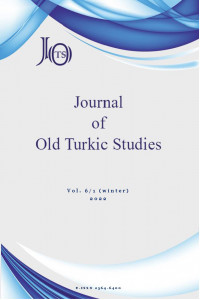Articles
Reviews
Aim & Scope
The JOTS is a refereed international journal which provides an interdisciplinary scholarly platform for original papers in the field of Medieval Turkic philology, history, culture and literature.
- The JOTS publishes original papers, translations, short communications, reviews and annunciations.
- The JOTS accept only manuscripts written in Turkish, German, English or French. Manuscripts written in other languages will not be accepted.
- The JOTS is published twice per year in January/February (winter) and July/August (summer). The Editorial Board may also decide for special issues.
- The JOTS is a completely free and open-access journal published online.
- The first and the most important criteria for the selection of papers for publication is originality and scholarly standing.
- Authors are responsible about article’s content and its consequences.
Author Guidelines
Preparation of Manuscript
1. JOTS does not request any fees from the authors or pay publishing royalties to authors in any way.
2. JOTS uses double-blind peer review for research articles.
3. Manuscripts should be single-spaced and with 2.5 cm margins for all sides. The font of the manuscript should be Times New Roman and the size of the body text should be 12 points.
4. The first page should contain the full name (last names fully capitalized) and affiliation of author(s) (university, city, country), and the contact E-mail address for the author(s).
5. The English abstract should provide clear information about the research and the results obtained. It should not exceed 250 words. The abstract does not need to be written in any other language than English. Please provide at least 3 keywords or phrases to enable retrieval and indexing.
6. Contributors who are not native Turkish, German, English or French speakers are strongly advised to ensure that a professional language editor has reviewed their manuscript.
7. Reviews should include author, title, publisher, ISBN number and number of pages. After providing a concise summary of the content, review should also include a critical analysis of a book in terms of its strengths and weaknesses.
8. Graphs and photographs should be numbered in sequence with numerals. Each figure should be identified with the figure number, its approximate location should be marked in the text.
9. Microsoft Office Word’s automatic features should not be used in the manuscript.
10. Reference should be given in parenthesis surname of author(s), publication date and page numbers; for one author references (Clauson, 1972: 354); for more than one author references (Bazin & Hamilton, 1972: 28). The references with more than two authors should be noted as (Georg et al., 1999: 67).
11. If the same author has more than one work on the same dates, than each of they should be added a, b, c letters.
12. There should be no plagiarism in the writings, the writing should not have been published elsewhere, there should be dependent on scientific research and ethics in publishing.
13. Authors should add their ORCID number to their manuscript before submitting.
14. Reference list should be set out in the alphabetical order at the end of the paper. APA (6th Edition) system should be used in the references as follows:
Clauson, Sir G. (1972). An Etymological Dictionary of Pre-Thirteenth Century Turkish. Oxford: Oxford University Press.
Bazin, L. & Hamilton, J. (1972). Un manuscrit chinois et turc runiforme de Touen-Houang. British Museum Or. 8212 (78) et (79). Turcica, 4, 25-42.
Georg, S. et al. (1999). Telling General Linguists about Altaic. Journal of Linguistics, 35(1), 65-98.
Schönig, C. (2012). Die hohe Kunst der Negation. In Erdal, M. et al. (Eds.), Botanica und Zoologica in der türkischen Welt Festschrift für Ingeborg Hauenschild (pp. 147-179). Wiesbaden: Harrassowitz Verlag.
Zieme, P. (1991). Gedanken zur Bearbeitung der alttürkischen buddhistischen Texte. In Klengel, H. & Sundermann, W. (Eds.), Ägypten, Vorderasien, Turfan. Probleme der Edition und Bearbeitung altorientalischer Handschriften (Tagung in Berlin, Mai 1987). (pp. 134-140). Berlin: Akademie Verlag.
Bazin, L. & Hamilton, J. (1972). Un manuscrit chinois et turc runiforme de Touen-Houang. British Museum Or. 8212 (78) et (79). Turcica, 4, 25-42.
Georg, S. et al. (1999). Telling General Linguists about Altaic. Journal of Linguistics, 35(1), 65-98.
Schönig, C. (2012). Die hohe Kunst der Negation. In Erdal, M. et al. (Eds.), Botanica und Zoologica in der türkischen Welt Festschrift für Ingeborg Hauenschild (pp. 147-179). Wiesbaden: Harrassowitz Verlag.
Zieme, P. (1991). Gedanken zur Bearbeitung der alttürkischen buddhistischen Texte. In Klengel, H. & Sundermann, W. (Eds.), Ägypten, Vorderasien, Turfan. Probleme der Edition und Bearbeitung altorientalischer Handschriften (Tagung in Berlin, Mai 1987). (pp. 134-140). Berlin: Akademie Verlag.
Ethical Principles and Publication Policy
Ethical Principles and Publication Policy
The editor and editorial board of JOTS are responsible for deciding which of the papers submitted to the journal will be published. The decision is based on the paper’s importance, originality, and the study’s impact and its relevance to the journal’s aim. The plagiarism are considered in particular. The editor does not give any information about a submitted manuscript to anyone other than the corresponding author, reviewers, and editorial board.
The reviewers support the editor and the editorial board of JOTS in making editorial decisions and may serve the author in improving the paper.
Authors should only submit original works to JOTS and avoid plagiarism. Submitting the same paper to more than one journal causes some kind of unethical behaviour (duplication). JOTS never accepts it.
When authors notice an important error in their own published work, they should report it the editor.
Price Policy
JOTS does not charge any fee for publishing process.

